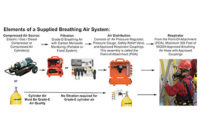Your two options for Grade D breathing air

Employers responsible for environments that require respiratory protection must ensure that exposed workers breathe good, clean air. According to OSHA Standard 29 CFR 1910.134, employers are required to provide employees who use respirators with breathing air that meets the requirements for Grade D breathing air.
Grade D breathing air, as described in ANSI/Compressed Gas Association Commodity Specification for Air, G-7.1-1989, includes the following1:
• Oxygen content of 19.5% - 23.5%
• Hydrocarbon content of 5 milligrams per cubic meter or less
• Carbon Monoxide (CO) content of 10 parts per million (ppm) or less
• Carbon Dioxide (CO2) content of 1,000 ppm or less
• Lack of noticeable odor
For respirator users, breathing air is primarily supplied by two different sources: oil-lubricated air compressors and ambient air pumps. While the end product is the same, the method by which it is provided, tested, and monitored can vary greatly. Let’s look at both of these options.
Oil-lubricated compressors
Oil-lubricated compressors are popular due to their ability to support numerous workers, along with their ability to provide enough pressure to operate many of the personal cooling devices offered by manufacturers today. Though popular, they are often not operated correctly according to the standard, putting many employees at risk.
By nature, carbon monoxide is created by the heating of oil, which can be pulled in through the air intake of the breathing air system (it is always recommended to ensure that the compressor’s air intake is placed away from engine exhaust or other sources of carbon monoxide). Because of this, employers are required to use high-temperature and/or carbon monoxide alarms to monitor the carbon monoxide levels being delivered to respirator users.
Several manufacturers offer airline filtration and monitoring systems, available in either permanently attached panel mounts, or more convenient portable hard cases. These systems not only filter the incoming air from the compressor for particulates and moisture, but they monitor the CO levels of the air in real-time before it reaches the respirator wearer. A similar option would be canister-style filtration units with a CO monitor attached, often through a small tubing hose. As these are more cumbersome, they are traditionally used in fixed locations, as well.
OSHA requires that air compressor systems be tested for air purity every six months by samples taken “at the connection to the distribution system”.2 For an air compressor or pump, that connection is most likely the coupler where the breathing air supply hose is inserted. These air tests can be conducted with results shared within 24 hours by kits available from numerous sources online. The American Industrial Hygiene Association (AIHA) Consultant Directory or OSHA Regional Office can assist in referring you to proper sources as well.
Ambient air pumps
Ambient air pumps (also known as rotary vane pumps) are another common air source for respirator users. These pumps are either driven by electricity or by air-driven motors. The electric pumps are not oil-lubricated; for lubrication, they often use carbon vanes, which cannot create carbon monoxide. The air-driven motors are driven by compressors, which drive the pump, but the breathing air supply lines are completely separated by motor blocks and manifolds, so no oil contamination can occur. Ambient air pumps are portable alternatives to air compressors, which do not require the expensive CO monitoring or high temperature alarms.3 Like an air compressor, their air intake (often an air filter connected directly or remotely to the pump unit) must be located in a clean air environment.
For indoor applications, these intakes are often located remotely, far enough away from the contaminant. Compared to compressed air options, the disadvantage of ambient air pumps is the lower air pressure being supplied to the respirator user, which can make some users feel stifled. Rest assured, though, that if the employee is using a NIOSH-approved respirator assembly, and they have set their regulator to the pressure assigned by the manufacturer (located on the pressure table for that assembly) they are achieving the NIOSH minimum requirement for air flow.
A few important facts for employers and respirator users to keep in mind:
1. Neither the air filtration units nor the ambient air pumps create Grade D air – they only help to maintain it.
2. For CO monitors, there is no specified requirement by OSHA that dictates how often units must be calibrated. Most manufacturers will recommend monthly calibrations in addition to calibrations whenever the readings are questionable or the air source has changed. This should be dictated in the employer’s respiratory protection program.
3. When the CO monitor alarms, there is usually a reason. In the field, it is common to see users who have turned the monitor off “because it was always alarming”. If an OSHA inspector were to visit, this would likely be a violation.
Lots of money has been spent on these units, and they are in place for your health and safety. When a unit alarms, please take a few minutes and investigate. Air compressors are machines and require maintenance. Sometimes the fix can be very easy. Other times it can be more complicated. Either way, it pales in comparison to the risk to someone’s life.
Stay safe and keep breathing the good air.
1 OSHA 29 CFR 1910.134(i), (i)(1)(ii), (i)(1)(ii)(A) – (E)
2 OSHA 29 CFR 1910.430(b)(4)
3 OSHA letter 7/5/1994
Looking for a reprint of this article?
From high-res PDFs to custom plaques, order your copy today!






